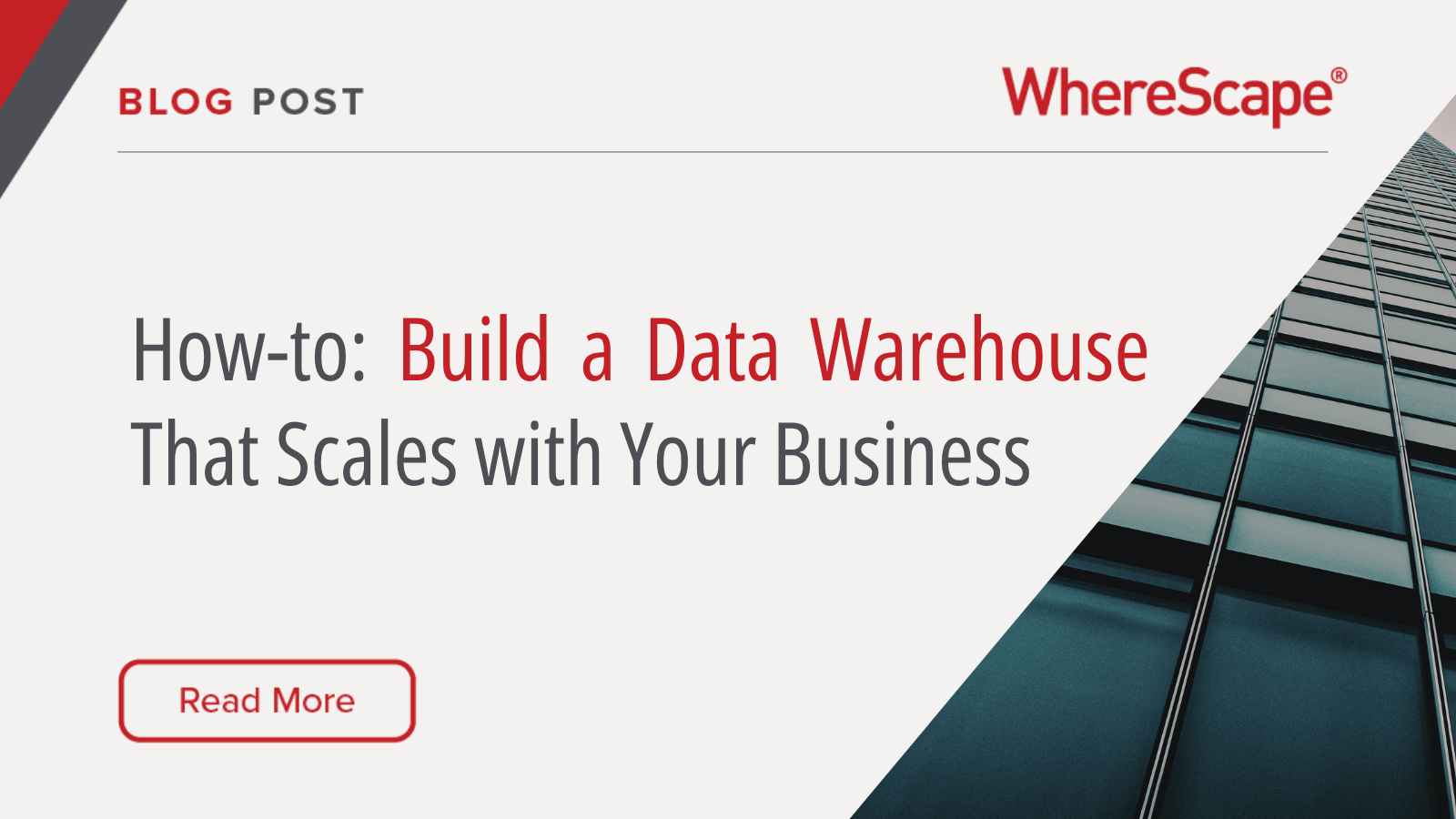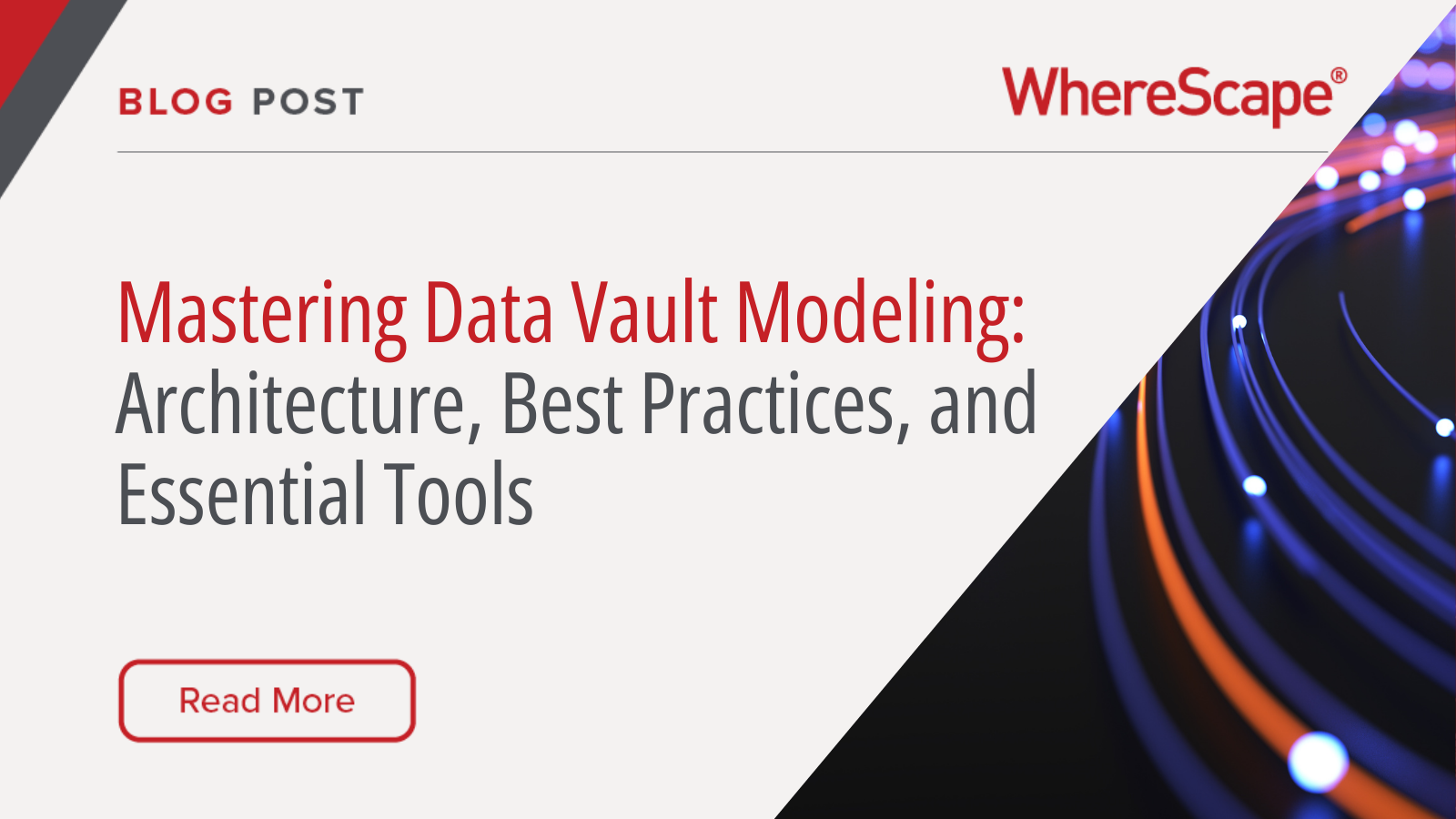Data Vault modeling enables teams to manage large, rapidly changing data without compromising structure or performance. It combines normalized storage with dimensional access, often by building star or snowflake marts on top, supporting accurate lineage and audit trails.
In this post, we’ll explain what Data Vault modeling is, how it differs from star and snowflake schemas, and the practical benefits of adopting it for long-term scalability and auditability. You’ll also see how automation platforms like WhereScape simplify and accelerate every phase of Data Vault development, from modeling to deployment.
What Is Data Vault Modeling?
Data Vault modeling is for designing enterprise data warehouses that balance flexibility, governance, and historical accuracy. It structures data into three core components: hubs, links, and satellites.
Each of these serves a distinct purpose:
- Hubs store unique business keys, like customer or account IDs, that define core entities.
- Links represent relationships between hubs, such as transactions or connections.
- Satellites capture contextual or descriptive data that changes over time, like customer status or product pricing.
This separation preserves history and makes change management easier. It also enables agile adaptation to new data sources or schema changes without redesigning the entire warehouse.
Compared to dimensional models, which often require refactoring when structures evolve, the Data Vault approach offers a future-proofing that scales with business complexity. It’s useful in industries where data change tracking matters, such as finance, healthcare, and manufacturing.
Key Advantages of Data Vault Modeling
The value of Data Vault modeling lies in its ability to adapt and scale without compromising data integrity. It’s built for systems that change fast. Think frequent schema updates and pipelines that need to adapt without breaking.
Flexibility in schema evolution
Traditional modeling techniques often struggle when new source systems or attributes are introduced. The Data Vault structure, built around hubs, links, and satellites, allows new data sources to be added with minimal disruption. Teams can expand data coverage without redesigning existing models, making it ideal for organizations that manage complex or fast-changing environments.
Built-in auditability
Every change in a Data Vault is preserved rather than replaced, creating a complete historical record of how data has evolved. This traceability supports compliance requirements such as HIPAA, SOX, and GDPR, while giving analysts confidence in the accuracy of their outputs. When questions arise about how or when data was updated, the lineage is clearer and easier to follow.
Scalability and performance
Data Vault modeling scales naturally across large datasets and distributed systems. Decoupling business keys from descriptive data lets teams parallelize workloads and optimize for hybrid environments. This separation of concerns not only speeds up loading and querying but also improves system reliability over time.
Simplified integration and automation
When paired with automation platforms like WhereScape, Data Vault modeling becomes even more powerful. WhereScape’s metadata-driven automation eliminates repetitive coding tasks, automatically generates lineage and documentation, and ensures consistency across the full lifecycle of your warehouse. By automating model generation, transformation, and orchestration, teams can deliver governed, production-ready Data Vaults in days instead of months.
Common Challenges in Data Vault Modeling
There are many benefits to Data Vault modeling, but building and maintaining one manually can be complex. The framework introduces a disciplined structure, but that structure requires significant ongoing management to stay consistent across environments.
The main challenges teams face include:
Complexity of Data Vault 2.0 design
Data Vault 2.0 expands on the original methodology to improve scalability, agility, and integration. It introduces Point-in-Time (PIT) tables and Bridge tables to simplify joins and speed up queries, but these additional layers also increase the number of components developers must design, test, and maintain.
Each part of the model serves a distinct role:
- Hubs define and store business keys.
- Links represent relationships between business entities.
- Satellites capture descriptive attributes and change history.
- PIT tables provide time-based snapshots for easier querying.
- Bridge tables pre-calculate common joins to improve performance.
Manually managing these objects across large data ecosystems introduces significant challenges:
- Every new data source requires custom code for hubs, links, and satellites.
- Schema changes can break dependencies, forcing rework across multiple tables.
- Maintaining consistent naming conventions and lineage documentation becomes difficult at scale.
- Testing and validation must be repeated for every change to preserve data integrity.
In large enterprises with hundreds of entities, this manual upkeep can slow delivery and introduce errors.
Repetitive manual work
Developers often spend hours writing SQL for similar objects across different source systems. The repetitive nature of this work makes it difficult to maintain consistent naming conventions, lineage, and documentation. Even small schema changes can require rewriting multiple scripts.
Steep learning curve
For teams new to the methodology, Data Vault’s strict structure and terminology can feel intimidating. Understanding the relationships between hubs, links, and satellites takes time, and implementing them without the right tooling can lead to inconsistent results or missed dependencies.
Difficulty maintaining governance
As the number of objects grows, so does the challenge of tracking lineage and documenting changes. Manual documentation is rarely kept up to date, which undermines one of Data Vault’s core goals: complete auditability.
Automation helps overcome these challenges by handling the repetitiveness and manual input that Data Vault 2.0 requires. It also connects the Data Vault foundation to downstream models like star and snowflake schemas, ensuring that every layer of the warehouse stays aligned and audit-ready.
Data Vault Modeling: Star and Snowflake Schemas
Star, Snowflake, and Data Vault modeling each serve a purpose in how organizations design and use data. The goal isn’t to replace one with another but to understand how they complement each other within a complete warehouse architecture.
| Model | Purpose | When it’s used | Structure |
| Data Vault | To store raw, historical, and integrated data from multiple systems in a flexible, auditable way. | In the data warehouse layer that sits between source systems and presentation models. | Hubs (business keys), Links (relationships), Satellites (context & history). |
| Star Schema | To make data simple and fast to query for reporting and dashboards. | In the presentation or data mart layer, often built on top of a Data Vault. | Central fact tables with connected dimension tables. |
| Snowflake Schema | A variation of Star Schema that adds more normalization (splits out dimensions for less redundancy). | Also in the presentation layer, especially in enterprise or cloud platforms where space, hierarchy, or control matter. | Fact and dimension tables, but with more joins and structure. |
Star schema
A star schema organizes data around a central fact table linked to dimension tables. It’s simple, fast to query, and built for reporting. Its clear relationships make it the standard model for most business intelligence workloads.
Snowflake schema
A snowflake schema adds structure by normalizing dimension tables. This reduces redundancy and enforces stronger relationships between data points. It’s often used in large or cloud-based systems, where accuracy and governance matter as much as speed.
Data Vault modeling
Data Vault modeling extends these approaches. It separates data into hubs, links, and satellites to capture every change over time while maintaining flexibility for new sources. The result is a model that scales easily, preserves history, and supports both dimensional and operational use cases.
WhereScape supports all three models within one platform, making it easier for teams to design, automate, and maintain the structure that fits their analytics strategy.
The Data Vault forms the foundation, while star and snowflake schemas present that data in formats optimized for analytics and reporting. But managing these layers manually takes significant time and effort. That’s where automation becomes essential.
The Measurable Impact of Data Vault Modeling Automation
Automation transforms Data Vault modeling from a manual, time-intensive process into a governed and repeatable workflow.
Automation adds four measurable advantages:
Faster delivery
Automation shortens delivery timelines by removing repetitive coding and manual testing. Projects that once required months of scripting can move to production in weeks. Metadata templates, built-in lineage, and standardized deployment steps keep development consistent across environments.
Stronger governance
Every change, from ingestion to transformation, is documented automatically. Teams can trace data paths and how they changed without maintaining separate audit logs.
Lower operational cost
Automation cuts repetitive SQL and scripting work at scale. In Databricks and Snowflake environments, WhereScape benchmarks show up to a 95 percent reduction in manual coding. That translates to fewer developer hours, fewer errors, and lower maintenance costs. A single metadata layer manages orchestration, lineage, and deployment, so teams spend less time fixing pipelines and more time delivering value.
Scalable foundation for analytics and AI
Automation enforces structure and data trust at scale. By maintaining a clean metadata framework, Data Vaults become reliable sources for analytical and AI workloads. Teams can train models or run predictive analytics without worrying about data gaps, versioning issues, or lineage loss.
How WhereScape Accelerates Data Vault Modeling Development
Building a Data Vault manually, and then star and snowflake schemas, can be time-intensive. WhereScape helps bring automation to your Data Vault modeling by using metadata to maintain every object in the warehouse.
Eliminating repetitive coding
With automation, model objects are created directly from metadata rather than manual SQL scripts. Platforms like WhereScape automatically generate hub, link, and satellite structures, manage dependencies, and handle transformations across multiple platforms.
Enforcing governance by design
Automation ensures that governance, lineage, and documentation are embedded in the process and not added later. WhereScape RED automatically documents every data flow and transformation, providing complete visibility into where data originated and how it changed.
Speeding up delivery cycles
Manual modeling can take months to reach production. Metadata-driven automation enables teams to move from design to deployment in a fraction of the time. WhereScape 3D allows data architects to model a Data Vault visually, then push those designs directly into production through WhereScape RED.
Supporting hybrid and cloud environments
Automation keeps every environment consistent. WhereScape’s platform-agnostic design supports leading environments like Snowflake, Databricks, and Microsoft Fabric, enabling seamless transitions without major rework. Teams can scale or migrate without refactoring.
Bring Automation to Your Data Vault Modeling with WhereScape
Automation has helped change the way Data Vaults are being built and managed. WhereScape gives data teams a way to deploy models without writing every line of code by hand. The platform handles documentation, lineage, and orchestration automatically, so projects move faster and stay consistent as they grow.
Teams use it to modernize existing warehouses or create new ones on Snowflake, Databricks, and other cloud platforms. What used to take months can now be done in weeks, with fewer errors and less manual upkeep.
Book a free 20-minute demo with a Solution Architect to see how your team and entire organization can start scaling.
FAQ
Data vault modeling is used to design enterprise data warehouses that can scale, evolve, and track historical changes. It provides a flexible structure for integrating data from multiple systems while maintaining full auditability and governance.
Unlike star or snowflake schemas, which can require heavy rework when data sources change, data vault modeling separates business keys and attributes into hubs, links, and satellites. This modular approach makes it easier to add new data sources without redesigning existing structures.
Automation accelerates every stage of Data Vault development. It eliminates manual coding, enforces governance automatically, and reduces time-to-production from months to weeks. Platforms like WhereScape also generate lineage and documentation automatically.
Yes. Modern automation tools like WhereScape RED and WhereScape 3D support hybrid and cloud environments including Snowflake, Databricks, and Microsoft Fabric, allowing teams to migrate or scale without major rework.
Data vault modeling is ideal for organizations in regulated or data-intensive industries such as finance, healthcare, and education.
Yes. WhereScape Data Vault Express (DVE) is purpose-built for automating Data Vault 2.0, generating hubs, links, satellites, and loads directly from templates. Want to dig deeper into Data Vault modeling? Browse more insights and technical articles in the WhereScape Resource Center.




